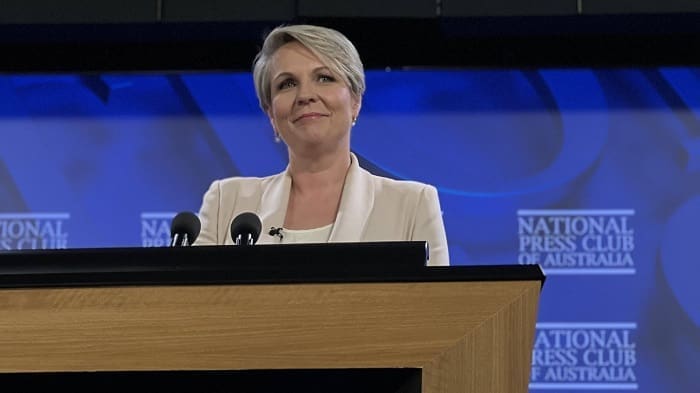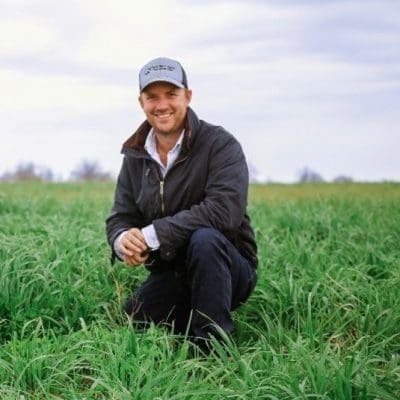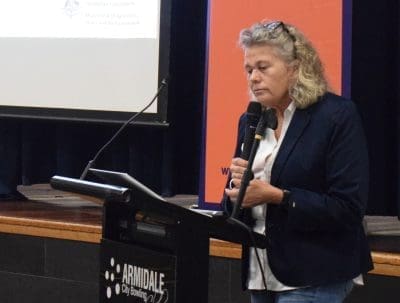
Tanya Plibersek delivering an address to the National Press Club in response to the State of the Environment report. Picture: Twitter
FEDERAL environment minister Tanya Plibersek has raised some eyebrows after she announced the government had plans to protect 30 percent of the country’s land by 2030 – with increasing the number of national parks on the agenda.
Ms Plibersek was responding the State of the Environment report which painted a dire picture of Australia’s environment and biodiversity. Grazing featured heavily in the report and the minister announced plans to lock up more land.
But the prospect of more national parks has raised some concerns in the agricultural industry, with endless complaints of mismanagement leading to pest problems and bushfires.
Current parks ‘massively underfunded and mismanaged’
Central Queensland producer and Agforce cattle board member Adam Coffey has long been critical of the management of Bulburin National Park, which neighbours his property.
 He told Beef Central last year his property had been threatened by fires in the park for the past five years and there was a lack of proactive fire management.
He told Beef Central last year his property had been threatened by fires in the park for the past five years and there was a lack of proactive fire management.
Mr Coffey said he was concerned about the prospect of more national parks.
“Why would we be making more national parks when the current parks are massively underfunded and mismanaged,” he said.
“Imagine the fires if we increased the number of national parks we have. Has anyone calculated the biodiversity loss from the large forest fires in National Parks we’ve seen in recent years? The huge carbon emissions? Why would anyone think it is a good plan to multiply this environmental catastrophe?
“It is a pretty broad statement at the moment, but I hope the environment minister engages with landholders on this.”
Biodiversity in grazing
Mr Coffey said there was opportunities for the government to help producers increase biodiversity. He said it could review its biodiversity offsets program where measures are put in place to compensate for actions which adversely impact the environment.
“We looked into an environmental offset opportunity here, but we knocked it on the head because they wanted to take cattle off a big part of our property,” he said.

“We operate a time-controlled grazing enterprise and could demonstrate we only grazed these areas for an average of 33 days per year. However, this still did not fit within the rigid parameters set by the Department.
“All we asked for was an opportunity to prove our case over time. We have A Grade koala habitat and had a tremendous opportunity to re-establish Koalas in an area where they haven’t recovered since being hunted out in the 1920’s.
“We wanted to demonstrate to them that the way we manage our cattle will actually increase biodiversity – but removing cattle was a non-negotiable for them. It was completely process driven and not outcome driven, which is something the minister could look into if the government is serious about this.”
Mr Coffey said agriculture and the environment had a lot in common – which he said was acknowledged by agriculture minister Murray Watt.
“Minister Watt has spoken publicly about the desire to bridge the perceived gap between agriculture and the environment so I hope that we take this opportunity,” he said.
“Let’s not forget that some 80pc of private land in QLD is remnant vegetation, thus protected by law. Landholders are a crucial piece of the puzzle in terms of stewardship of this land. We’ve spent a bit of time with ecologists who’ve visited to conduct habitat surveys and our experience is that we have far more in common than many would think.”
NFF calling for collaboration
NFF President Fiona Simson said locking up the Australian landscape was not the answer to improving biodiversity.
“Farmers are the custodians of 55 per cent of Australian land and not only do farmers want to protect the land, they also want to improve it for generations to come,” Ms Simson said.

NFF president Fiona Simson says an agriculture-wide sustainability framework will be released this year.
“It’s in farmers’ best interests to care for the environment, as productive landscapes rich in biodiversity mean they can grow the food and fibre to feed and clothe Australians and the world.
“Locking up land is not the answer. It has the potential to have the reverse effect on biodiversity, with a lack of land management allowing feral animals and plants to flourish, as well as heightening the risks from fire, drought and flood.
Ms Simson said locking up land could have an adverse impact on biodiversity.
“Farmers continue to do significant heavy lifting to implement controls on their own land, only to have it reinvaded and infested time and again from lack of management on public lands,” he said.
“Farmers are already leading the field and we are ready to do more to reduce the spread of invasive species as they not only damage the environment, but adversely impacting agriculture. For example, feral pigs are wreaking havoc in Australia, including contributing to lamb mortality, trampling crops, destroying water quality, and are a significant vector for disease spread while their impact on native flora and fauna is equally damaging.
“The NFF has for a long-time recognised opportunities to help manage biodiversity and other natural capital assets and ensuring sensible exclusions are maintained. Those processes have already commenced and need to be supported by government.”
Not locking up agricultural land: Plibersek
In response to Beef Central’s questions, Ms Plibersek said the government had plans to work with the agricultural industry on achieving its target.
“Currently we have 22pc of our land protected, with plans in place to get to close to 27pc. None of this involves agricultural land,” she said.
“We will be consulting widely in how we can best deliver the remaining 3pc of this target – including with industry and agriculture.
“The National Farmers Federation has said that farmers are ‘part of the solution to reverse biodiversity decline’ and I couldn’t agree more. It’s just mischief to say that we will be locking up agricultural land – we want to protect the landscapes we need to, but also encourage farmers to enhance the biodiversity on their own properties.
“Farmers are fantastic stewards of the remnant vegetation on their own land and we want to support them to continue to do this as well as adding to our national reserve.”

What makes me SO FRUSTRATED is our agricultural so-called representatives remaining silent until it is too late, & even then still failing to address the cause of policy issues. We continually fluff glossy words about the symptoms of policy rather than discussion the source the policy itself, & what we get is continually lost ground. Death by a thousand cuts.
This plan to lock up land was clearly layed out in the early 70s, & people tried to warn then .. but were ignored.
Australian Government has been on board with the Convention on Biological Diversity since 1993 … silence from our Ag representatives.
The UN target is to lock up (read: take out of family ownership & give to elitists ownership) 30% of land & 30% of sea.
Morrison signed on to lock up an *aggregate* of land & sea totalling 30%, & copped flak from extreme fake greens for not going far enough … still silence.
Labor is now going the whole UN hog of 30% land and 30% sea.
FINALLY, some kind of recognition from the NFF!! Thankyou!
Are we FINALLY going to start taking these treaties seriously & publicly DISCUSSING their impact & actually PUSHING BACK??
~
https://en.m.wikipedia.org/wiki/Convention_on_Biological_Diversity
~
https://www.acf.org.au/australia-joins-global-biodiversity-alliance
A bit like Kerry Packer’ comment about paying income tax ( if I saw you spending it more wisely , I would be happy to pay more )
If we saw governments of all levels managing public lands better , maybe we would be more confident of management of parks and accept more of them
It seems to be generally agreed that management of national parks is substandard .
Why do we want more parks when governments can not manage what they now have ?
The traditional or indigenous landscape was more open and maintained by regular fires
Most surveys indicate the landscape has greened up
Is “pulling” or “clearing” just a modern replacement of what the indigenous people did with fire to keep the landscape more open and manageable?
Tanya – put up or shut up !